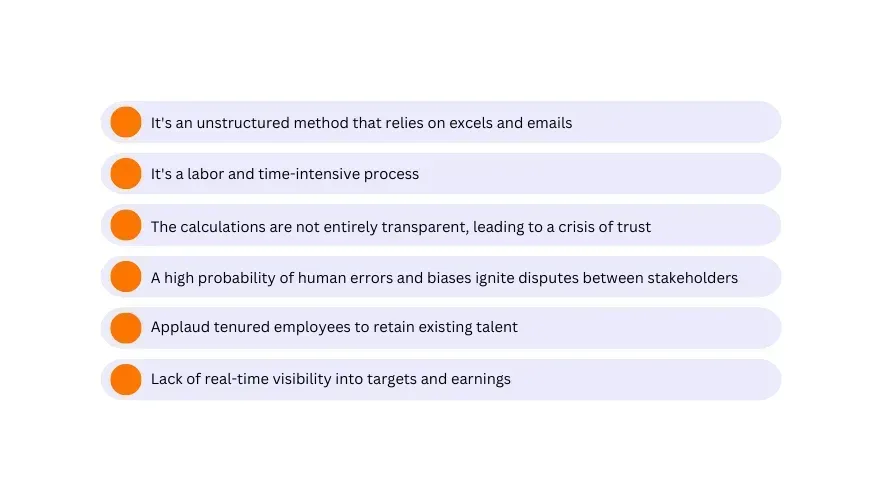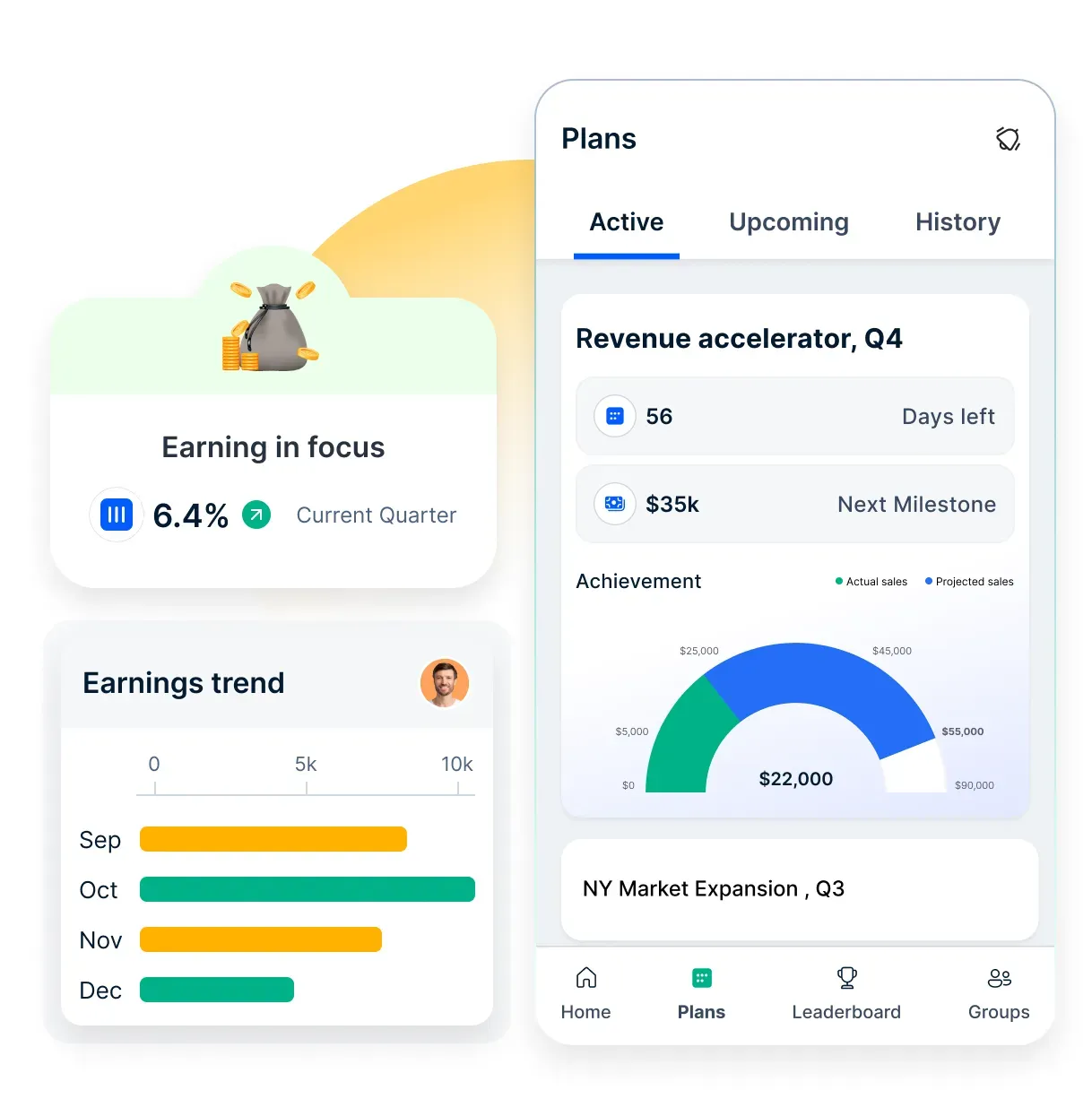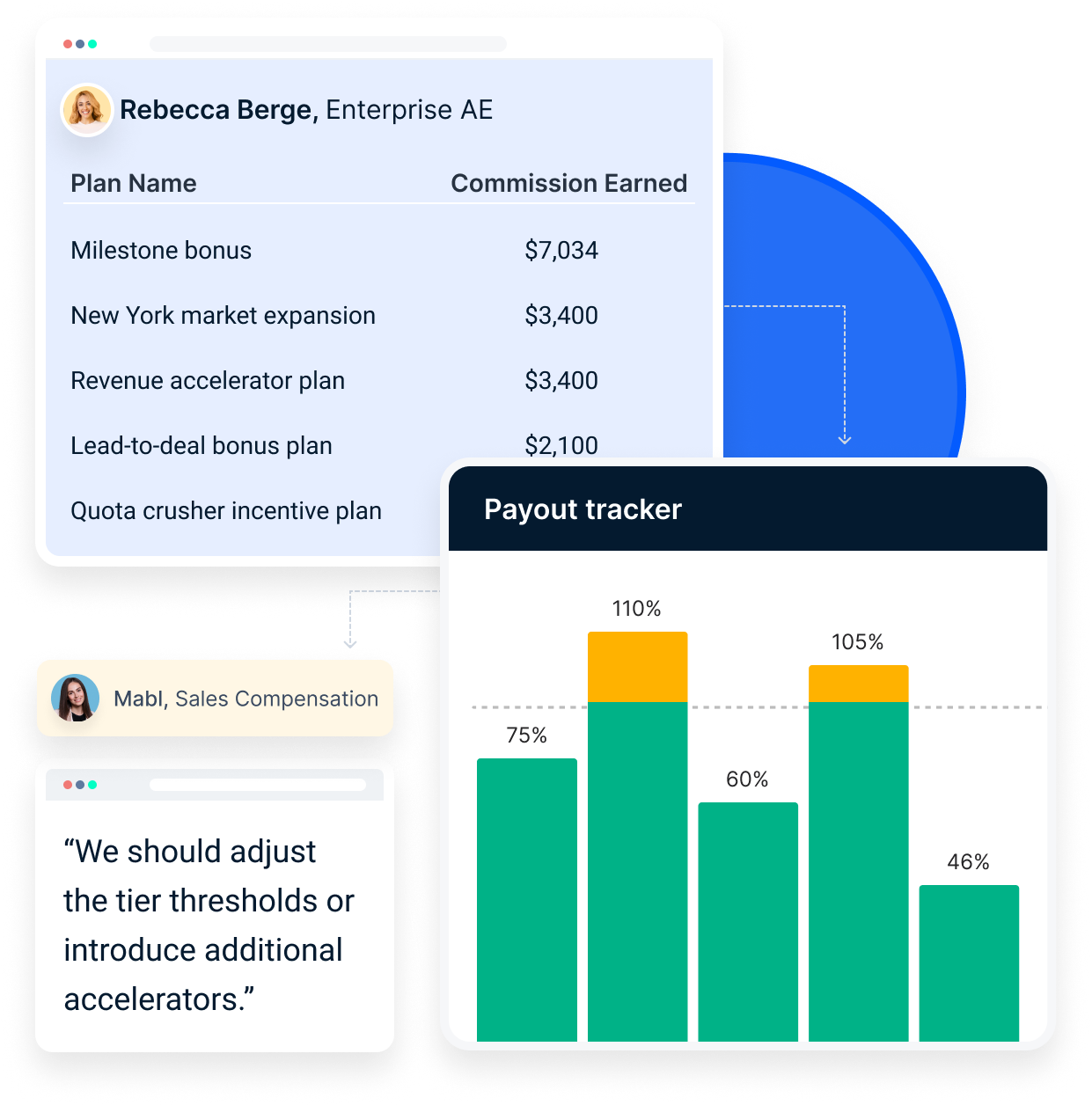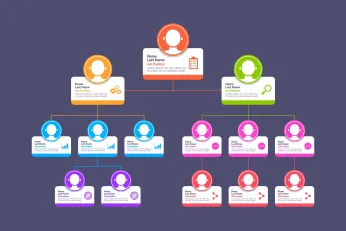3 Alasan Berinvestasi dalam Perangkat Lunak Otomatisasi Penjualan untuk Pertumbuhan
Jelajahi alasan utama untuk berinvestasi dalam perangkat lunak otomasi penjualan dan bagaimana perangkat lunak ini meningkatkan perkiraan penjualan, mengurangi kesalahan, dan meningkatkan transparansi keuangan untuk pertumbuhan bisnis yang berkelanjutan.
Di halaman ini
Program insentif telah lama ada untuk melibatkan, menginspirasi, dan meningkatkan penjualan dan pertumbuhan mitra saluran dengan memotivasi tindakan penjualan yang diinginkan dalam skala yang lebih besar. Meskipun sifatnya yang bervariasi, kita tidak dapat menyangkal dampak langsungnya terhadap kesuksesan organisasi.
Program insentif yang berkualitas dapat meningkatkan kinerja penjualan sebanyak 44%.(Sumber:IRF)
Sebagian besar perusahaan menggunakan insentif keuangan dan non-keuangan untuk mencapai hasil kinerja penjualan yang diinginkan.
Namun, sebagian besar organisasi tidak memiliki teknologi atau pengetahuan untuk membuat program yang terstruktur dengan benar untuk mengelola dan mengukur perhitungan insentif mereka. Hal ini menyebabkan gambaran yang tidak tepat mengenai total hasil kinerja dari penjualan dan pengukuran ROI insentif yang tidak akurat. Selain itu, sifat perhitungan yang sebagian besar masih manual membuat analisis waktu nyata menjadi hampir tidak mungkin dilakukan.
Artikel ini akan membahas pentingnya menyusun program insentif Anda dan berinvestasi dalam Platform Otomasi Insentif untuk meningkatkan keuntungan Anda.
Tantangan yang ditimbulkan oleh proses penghitungan dan pengelolaan insentif secara manual
Tidak seperti CTC, hasil bisnis mendorong insentif, dan perhitungannya bergantung pada laba penjualan. Pada tingkat dasar, rumus untuk menghitung pembayaran insentif berbasis penjualan adalah sebagai berikut:

Seiring dengan pertumbuhan organisasi, faktor-faktor lain, termasuk komisi, bonus, dll., mempengaruhi perhitungan ini. Hal ini menyulitkan dalam membuat skala perhitungan.
Sebagian besar program insentif bergantung pada proses penghitungan manual di mana satu atau dua sumber daya manusia yang ditunjuk harus menggunakan lembar excel dan email untukmenghitung kompensasi insentifuntuk setiap perwakilan penjualan dan mitra saluran. Beberapa kelemahan dari penghitungan insentif secara manual adalah:

3 Alasan mengapa Anda harus mempertimbangkan untuk mengotomatiskan rencana kompensasi insentif
Ada tiga alasan mengapa Anda harus mempertimbangkan untuk mengotomatiskan kompensasi insentif. Baca terus untuk mengetahuinya.
1. Memperkirakan dengan perangkat lunak otomatisasi penjualan
Salah satu alasan paling kuat untuk berinvestasi dalam perangkat lunak otomasi penjualan adalah kemampuannya untuk meningkatkan akurasi perkiraan. Dengan mengkonsolidasikan data kinerja penjualan ke dalam satu sistem, bisnis mendapatkan pandangan historis yang nyata tentang kinerja perwakilan - lebih dari sekadar kuartal saat ini.
Hal ini memungkinkan para pemimpin penjualan untuk menganalisis aspek-aspek utama seperti:
- Bagaimana keterampilan staf penjualan berkembang dari waktu ke waktu
- Performa mereka saat ditugaskan ke wilayah baru
- Keakuratan penilaian pipa mereka di masa lalu
- Wawasan tambahan yang meningkatkan prakiraan penjualan saat ini
Metode peramalan tradisional membutuhkan upaya manual yang signifikan, membuat analisis ini memakan waktu yang lama-sering kali mencegah analisis tersebut dilakukan. Dengan otomatisasi bisnis kompensasi insentif, tim penjualan dapat mengakses wawasan ini secara instan, sehingga mereka dapat menyempurnakan strategi dan mendorong hasil pendapatan yang lebih dapat diprediksi. Perkiraan yang lebih baik menguntungkan seluruh organisasi dengan mengoptimalkan alokasi sumber daya dan memastikan pengambilan keputusan yang lebih cerdas.
Compass menghilangkan kesalahan dan penundaan manual dengan mengotomatiskan tugas-tugas manajemen kompensasi insentif (ICM). Dengan kalkulasi otomatis, templat yang telah dibuat sebelumnya, dan tanpa pekerjaan manual, Compass memastikan prakiraan kompensasi yang akurat. Analisis prediktif, tolok ukur, dan wawasan efektivitas rencana dari platform ini membantu organisasi menyempurnakan strategi penjualan mereka berdasarkan data, bukan tebakan. Selain itu, Compass menawarkan laporan wilayah dan analisis tren pembayaran, yang memungkinkan bisnis untuk membuat keputusan yang tepat tentang perkiraan penjualan dengan penuh keyakinan.
2. Mengelola biaya kompensasi secara efisien
Tim keuangan merupakan sekutu utama ketika menerapkan otomatisasi kompensasi insentif, karena secara langsung berdampak pada efisiensi biaya. Bisnis rata-rata mengalokasikan 10% dari pendapatan tahunan untuk kompensasi, dengan Gartner melaporkan bahwa 3-5% dari biaya kompensasi penjualan mengakibatkan pembayaran yang berlebihan.
Dengan program insentif otomatis, perusahaan dapat mengidentifikasi dan mengeliminasi kelebihan pembayaran ini, memastikan komisi didistribusikan secara akurat. Hal ini tidak hanya mengurangi pengeluaran yang tidak perlu tetapi juga meningkatkan transparansi keuangan, sehingga perusahaan dapat menginvestasikan kembali pendapatan yang dihemat ke dalam inisiatif pertumbuhan.
Compass menyediakan pemodelan rencana kompensasi insentif yang kuat bagi organisasi, sehingga mereka dapat menguji rancangan rencana kompensasi sebelum diimplementasikan. Dengan menjalankan pemodelan skenario bagaimana-jika di seluruh peran, bisnis dapat memastikan struktur komisi selaras dengan target pendapatan. Analisis biaya penjualan, wawasan investasi vs. pendapatan, dan alat perbandingan rencana memungkinkan perusahaan untuk menyesuaikan strategi insentif mereka secara real-time, menghilangkan pembayaran yang berlebihan dan memaksimalkan profitabilitas.
3. Meningkatkan efisiensi SDM dan retensi penjualan
Perwakilan penjualan mungkin akan diam saja tentang kesalahan komisi yang menguntungkan mereka, namun mereka akan segera menyuarakan kekhawatiran ketika dibayar rendah. Di beberapa organisasi, perselisihan mengenai komisi menghabiskan waktu berjam-jam setiap hari, sehingga menimbulkan gesekan antara tim penjualan dan pimpinan.
Ketidakpercayaan ini juga meluas ke sumber daya manusia. Menurut State of Global Enterprise Sales Performance Report 2021, omset penjualan sukarela meningkat pada tahun 2020, dengan 58% perusahaan mengalami omset yang lebih tinggi daripada tahun 2019. Meskipun perubahan industri berkontribusi pada tren ini, kurangnya kepercayaan terhadap akurasi kompensasi juga berperan.
Perputaran karyawan yang tinggi memberikan beban berat bagi tim SDM, memaksa mereka untuk terus menerus melakukan perekrutan dan orientasi. Workable melaporkan bahwa pada tahun 2020, rata-rata peran penjualan membutuhkan waktu 48 hari untuk diisi. Perusahaan yang mengalami tingkat pergantian karyawan rata-rata 27% di industri ini menghadapi tantangan perekrutan yang berkelanjutan. Dengan memanfaatkan otomatisasi insentif untuk memastikan kompensasi yang adil dan akurat, perusahaan dapat mengurangi pergantian karyawan menjadi sekitar 15%, mengurangi upaya perekrutan secara signifikan dan memungkinkan SDM untuk fokus pada kebutuhan organisasi yang lebih luas.
Compass menumbuhkan budaya tim yang kolaboratif dengan menyediakan rencana insentif yang transparan dan sistem manajemen perselisihan yang terstruktur dalam aplikasi, mengurangi eskalasi dan memastikan tenaga penjualan menerima pembayaran yang akurat. Dengan menghilangkan kesalahan pembayaran, Compass memperkuat kepercayaan antara perwakilan penjualan dan manajemen, sehingga mengurangi tingkat perputaran. Selain itu, platform ini memungkinkan organisasi untuk mengumpulkan umpan balik secara real-time mengenai rencana kompensasi, menyempurnakan struktur berdasarkan masukan dari perwakilan, dan memastikan keselarasan dengan tren pasar. Dengan sistem manajemen insentif yang efisien, tim HR dapat fokus pada perekrutan talenta terbaik sekaligus mengurangi waktu yang dihabiskan untuk menyelesaikan perselisihan kompensasi.
Berinvestasi dalam otomatisasi kompensasi insentif merampingkan operasi keuangan, meningkatkan akurasi prakiraan, dan menumbuhkan kepercayaan antara tim penjualan dan pimpinan-yang pada akhirnya mendorong kinerja yang lebih baik dan pertumbuhan bisnis yang lebih kuat.
Keuntungan berinvestasi dalam platform otomatisasi insentif
Saat ini, meningkatnya popularitas otomatisasi Insentif membuat banyak Pemimpin SalesOps dan RevOps mempertanyakan perlunya berinvestasi dalam perangkat lunak yang mahal untuk mengotomatisasi komisi vs. terus menggunakan satu atau dua sumber daya untuk menghitungnya secara manual.
Untuk menjawab hal ini, kita perlu melihat munculnya incentives automation (IA) sebagai solusi berbasis cloud yang berbeda yang menggabungkan beberapa modul ke dalam satu strategi berbasis perilaku yang memengaruhi kinerja penjualan secara global dengan mempercepat waktu menuju pendapatan.
Otomatisasi Insentif (AI) saat ini membawa program insentif dari intuisi menjadi sebuah ilmu pengetahuan, memastikan merek menggunakan bauran, tingkat, dan irama insentif yang tepat untuk meningkatkan pendapatan dan keuntungan dari saluran tersebut.(Sumber:LinkedIn)
Sebagian besar platform otomatisasi insentif saat ini menggunakan algoritme pembelajaran untuk menentukan kisaran dan tingkat insentif berdasarkan profil individu dan riwayat perilaku. Dengan menganalisis audiens penjualan dan mitra saluran secara real-time, platform otomatisasi insentif dapat menghitung jumlah dan jenis insentif yang tepat.
Alih-alih menggantikan sumber daya yang mengelola penghitungan komisi dan insentif, penghitungan berbasis AI ini dapat menjadi alat yang ampuh untuk memberdayakan sumber daya yang ada untuk melakukan pekerjaan yang lebih strategis dengan menggunakan data dan wawasan real-time.
Dengan kata lain, platform otomatisasi insentif dapat memberdayakan semua orang untuk menjadi juara yang mendorong pendapatan, mulai dari tim penjualan dan mitra saluran hingga pemimpin penjualan, manajer komisi, dan tim keuangan.
Bagaimana otomatisasi insentif dapat memberdayakan mitra penjualan dan saluran?
Berikut ini adalah bagaimana otomatisasi insentif melalui Compass dapat membantu memberdayakan mitra penjualan dan saluran:
Bagaimana otomatisasi insentif dapat memberdayakan manajer?
Menerapkan otomatisasi insentif melalui Compass melengkapi para manajer dengan alat yang dibutuhkan untuk mendorong kinerja tim dan meningkatkan pendapatan.

Dengan memanfaatkan program insentif otomatis, manajer dapat merampingkan proses, menetapkan tujuan yang jelas, dan menggunakan wawasan waktu nyata untuk menjaga tim mereka tetap termotivasi.
Pantau kemajuan tim dan maksimalkan produktivitas
Dengan pelacakan waktu nyata, manajer dapat menetapkan target yang dapat dicapai dan menggunakan otomatisasi kompensasi insentif untuk memastikan tim mereka tetap termotivasi. Pendekatan ini menghasilkan produktivitas penjualan dan pertumbuhan pendapatan 10X lipat, sehingga menjadi salah satu alasan utama untuk berinvestasi pada perangkat lunak otomasi penjualan.
Kurangi perselisihan dengan transparansi
Compass memungkinkan para manajer untuk membuat struktur insentif berdasarkan kinerja, memastikan kejelasan dalam penghitungan komisi dan potensi pendapatan untuk setiap transaksi yang ditutup. Sistem yang transparan membantu mengurangi konflik dan menjaga kepercayaan di dalam tim penjualan.
Dapatkan keunggulan kompetitif dengan wawasan real-time
Dengan terus menyempurnakan otomatisasi bisnis kompensasi insentif, para manajer dapat menyesuaikan program insentif otomatis mereka agar sesuai dengan kondisi pasar yang terus berkembang. Compass memungkinkan para manajer untuk menganalisis tren pendapatan dan meniru model komisi yang sukses, memastikan pertumbuhan bisnis yang berkelanjutan.
Bagaimana otomatisasi insentif dapat memberdayakan administrator?
Bagi administrator, otomatisasi insentif menyederhanakan manajemen komisi dan memastikan efisiensi dalam skala besar.

Dengan Compass, mereka dapat memantau kinerja penjualan, mengotomatiskan pembayaran, dan mengukur dampak struktur insentif.
Memastikan pencairan pembayaran tepat waktu
Menghilangkan spreadsheet dan menerapkan otomatisasi kompensasi insentif memastikan bahwa perwakilan penjualan menerima pembayaran tepat waktu dan bebas dari kesalahan. Hal ini menghilangkan ketidakpastian pembayaran, sehingga staf penjualan dapat fokus pada penjualan.
Memperjuangkan pertumbuhan pendapatan yang lebih besar
Ketika perusahaan berinvestasi pada platform otomatisasi insentif yang baik, tujuan utamanya adalah untuk memberi manfaat bagi departemen penjualan. Namun, manfaatnya juga mengalir ke seluruh bagian perusahaan - memaksimalkan keuntungan, meningkatkan pangsa pasar, meningkatkan perkiraan, dan analisis data secara keseluruhan.
Pada akhirnya, ini menjadi senjata yang memberdayakan semua orang, mulai dari tim penjualan dan mitra saluran hingga manajer penjualan dan manajer komisi, untuk memperjuangkan pertumbuhan pendapatan yang lebih besar. Jadwalkan panggilan dengan Compass sekarang untuk mengetahui bagaimana Compass dapat menjadi penyelamat Anda.
Pertanyaan Umum
T: Bagaimana cara kerja kompensasi insentif?
J: Kompensasi insentif memberikan penghargaan kepada karyawan berdasarkan kinerja mereka, biasanya melalui komisi, bonus, atau pembagian keuntungan. Kompensasi ini menyelaraskan tujuan karyawan dengan tujuan bisnis, sehingga memotivasi mereka untuk mencapai target tertentu.
T: Apa yang dimaksud dengan alat ICM?
J: Alat bantu Manajemen Kompensasi Insentif (Incentive Compensation Management/ICM) mengotomatiskan penghitungan, pelacakan, dan distribusi pembayaran insentif. Alat ini memastikan akurasi, transparansi, dan efisiensi dalam mengelola rencana komisi.
T: Apa 3 insentif teratas yang diinginkan karyawan?
J: Tiga insentif teratas yang paling dihargai oleh karyawan adalah:
- Bonus berbasis kinerja - Imbalan uang untuk pencapaian target.
- Pilihan kerja yang fleksibel - Kerja jarak jauh atau jadwal yang fleksibel.
- Peluang pertumbuhan karier - Pelatihan, bimbingan, dan promosi.
T: Apa contoh rencana kompensasi insentif?
J: Contoh yang umum adalah rencana komisi penjualan, di mana perwakilan penjualan mendapatkan persentase pendapatan dari transaksi yang ditutup. Misalnya, perusahaan dapat menawarkan komisi 5% untuk setiap penjualan, dengan bonus tambahan untuk melampaui kuota penjualan.













